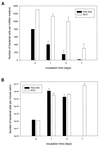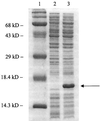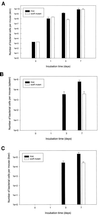Expression of the soxR gene of Pseudomonas aeruginosa is inducible during infection of burn wounds in mice and is required to cause efficient bacteremia
- PMID: 10496912
- PMCID: PMC96887
- DOI: 10.1128/IAI.67.10.5324-5331.1999
Expression of the soxR gene of Pseudomonas aeruginosa is inducible during infection of burn wounds in mice and is required to cause efficient bacteremia
Abstract
Burn wounds are prone to infection by Pseudomonas aeruginosa, which is an opportunistic pathogen causing various human diseases. During infection, the bacterium senses environmental changes and regulates the expression of genes appropriate for survival. A purine-auxotrophic mutant of P. aeruginosa was unable to replicate efficiently on burn wounds, suggesting that burn wounds are purine-deficient environments. An in vivo expression technology based on purEK gene expression was applied to the burned mouse infection model to isolate P. aeruginosa genes that are specifically induced during infection. Four such in vivo-inducible (ivi) genetic loci were identified, including the gene for a superoxide response regulator (soxR), the gene for a malate synthase G homologue (glcG), an antisense transcript of a putative regulator responding to copper (copR), and an uncharacterized genetic locus. SoxR of Escherichia coli is known to regulate genes involved in protecting the bacterium against oxidative stress. The expression of soxR was proven to be highly inducible during the infection of burned mice and also inducible by treatment with paraquat, which is a redox-cycling reagent generating intracellular superoxide. The SoxR protein functions as an autorepressor in the absence of paraquat, whereas in the presence of paraquat, this autorepression is diminished. Furthermore, a soxR null mutant was shown to be much more sensitive than wild-type P. aeruginosa to macrophage-mediated killing. In support of this observation, a soxR null mutant exhibited a significant delay in causing systemic infections in the burned mice. Since most mortality in burn patients is caused by systemic infection, the defect in the ability to cause efficient bacteremia in burned mice suggests an important role of the soxR gene in the infection of burn wounds.
Figures







References
-
- Adeniran A, Shakespeare P, Patrick S, Fletcher A J, Rossi L A F. Influences of a changed care environment on bacterial colonization of burn wounds. Burns. 1995;21:521–525. - PubMed
-
- Berger M M, Cavadini C, Bart A, Mansourian R, Guinchard S, Bartholdi I, Vandervale A, Krupp S, Chiolero R, Freeman J, et al. Cutaneous zinc and copper losses in burns. Burns. 1992;18:373–380. - PubMed
-
- Bodey G P, Bolivar R, Fainstein V, Jadeja L. Infections caused by Pseudomonas aeruginosa. Rev Infect Dis. 1983;5:279–313. - PubMed
-
- Boucher B A, Kuhl D A, Hickerson W L. Pharmacokinetics of systemically administered antibiotics in patients with thermal injury. Clin Infect Dis. 1992;14:458–463. - PubMed
Publication types
MeSH terms
Substances
Grants and funding
LinkOut - more resources
Full Text Sources
Medical

